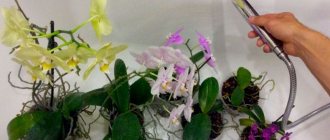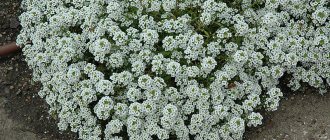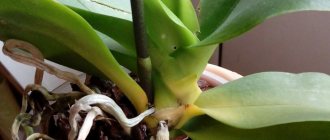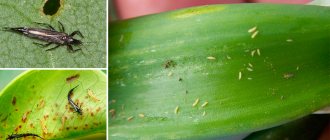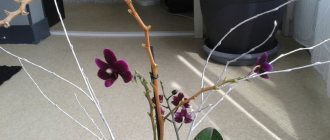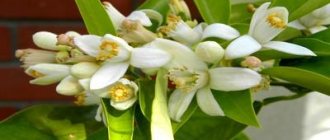Characteristics of the peduncle
A peduncle is a shoot of a plant on which buds, buds and seeds are formed. An orchid produces one shoot during the flowering period. With the help of an arrow, the flower reproduces.
The size of the shoot is from 10 to 30 cm. When the shoot reaches more than 10 cm, it should be tied up. The arrow should not be long. If the peduncle begins to grow more than 40 cm, the top is cut off by 2-3 mm.
The buds grow in the 2nd month from the beginning of the formation of the arrow.
The peduncle is responsible for flowering. In the process of growing an orchid, it is important to adhere to a number of rules so that the plant produces an arrow.
Care during the growth period of the peduncle
During the period of active growth, favorable conditions are created for the plant. Factors influencing growth include:
- Illumination. Little light will affect the development of the shoot.
- Watering. After the arrow begins to climb, the plant is watered as the soil dries out.
- Feeding. Feeding will help increase the number of buds. The orchid is fertilized before the first bud appears. Applying fertilizer after flowering has begun will cause the flowers to drop.
The flower cannot be replanted, as this causes stress. If the peduncle has stopped growing, it is cut off. The cut area should be treated with wood ash.
Damage to the peduncle
In the event of an arrow injury, the degree of damage is taken into account. If the shoot has been damaged superficially, it is treated with a mixture of ash and activated carbon, after which it should be strengthened with additional fixatives.
If the arrow is completely broken, the broken area is trimmed and treated with activated carbon. The shoot that breaks off is used for breeding.
How to tell if a plant is flowering
Orchids growing on the windowsill delight household members with abundant and beautiful flowering. The bright petals resemble the wings of butterflies. With proper care, the flower can actively bloom for several months. According to botanical data, the flowering period lasts from 2 to 6 months.
The first sign of the end of the flowering stage is the absence of new buds and the withering of already formed ones. At the same time, the arrow changes its color from rich green to dark brown. After 7–10 days, you can notice signs of the peduncle drying out. What to do next so that in the near future the exotic flower will throw out new buds? Let's figure it out.
A characteristic sign of the completion of the flowering stage is the drying of the peduncle
Orchid stimulation
Sometimes at home an orchid does not bloom for a long time. The reason for this is stable growth conditions.
In order for a home orchid to produce a peduncle, the plant is stimulated by stress. Stimulation is carried out in two ways - the drought method and temperature difference.
Drought method
Reducing watering causes the orchid to release a flower stalk. During the hot period, the flower is moistened 1 r. at 4 days, in cool weather – 1 r. in Week.
During this period, foliage is not sprayed. 10 days after reducing watering, the leaves of the plant become sluggish and the flower begins to shoot out an arrow. This method will force the orchid to produce buds again after a short break in flowering.
Temperature difference
In its natural environment, the orchid blooms in the spring, after cold weather. At home, it is important to create the same temperature.
To do this, the pot must be placed on a loggia or balcony. The temperature difference should be no more than 5 °C. This method will help to achieve flowering from an orchid that has been dormant for a long time.
How and when does the phalaenopsis orchid bloom?
So, first we need to understand one botanical feature of the development of our tropical guest. When does the phalaenopsis orchid bloom - the answer to this question hides the accompanying answers to all possible questions of inexperienced gardeners regarding why the orchid does not bloom for a long time. So, the phalaenopsis orchid blooms for the first time no earlier than 2 years from the moment of its planting. Therefore, if a flower is planted with the help of a child, then you should wait for at least 6 full-fledged leaves to form and then sound the alarm.
Immediately after planting, the plant begins to build up its root mass. Depending on planting conditions, this may take at least 6 months. And only after this the development of aerial roots and leaf mass begins. This is a very important time, since flower buds of future flower stalks are laid in the axils of new leaves. Therefore, as soon as the tops of new leaves begin to appear, you should begin actively feeding with mineral complexes. But be careful. It is best to exclude nitrogen from fertilizers or buy formulations where it is contained in the lowest ratio. Phosphorus, potassium and magnesium are needed to lay future flower stalks.
Another important point regarding the question of when orchids bloom. This tropical plant has no concept of changing seasons. In principle, it does not know that here, in our latitudes, there is winter and the time has come to shed the leaves and stop flowering. The phalaenopsis orchid is not particularly sensitive to the length of daylight hours, since under natural conditions it grows under the cover of dense foliage of the tropical forest. Therefore, the phalaenopsis orchid can bloom without interruption for up to 10 - 11 months. The time when it throws out a peduncle depends entirely on the skill and experience of the grower.
Orchid propagation using a peduncle
Reproduction by peduncle is more effective than seeds
The cut arrow of the plant is used to grow a flower at home. This method is considered more effective than propagation by seeds. Propagation of an orchid using a peduncle is carried out in two ways.
Stem cuttings
This procedure is carried out in late spring or early summer. Cuttings are cut in this way:
- The lower leaves are cut off.
- Sections are sterilized with activated carbon.
- The plant is fertilized with nitrogen fertilizer.
- After the roots have formed on the cuttings, the shoot is cut off.
After cutting, the peduncle needs to be planted in prepared soil. The young orchid should not be watered for two days to allow the plant to take root. After 2-3 months the flower will begin to grow. It is important to ensure that the cutting does not break during cutting.
Growing in water
This method is used if the flower is frozen, sick, or the peduncle breaks off before flowering begins.
Sequence of procedure:
- The cutting is placed in a bottle, after cutting off the neck by 5 cm.
- The container is filled with water with the addition of activated carbon. The shoot should be 4-5 cm in water.
- The scales on the arrow are cut off with a razor to awaken the bud
- The cut site is treated with cytokinin ointment.
If the shoot is broken, then the place where it was broken is cut off. The ointment is applied every week for a month. The liquid in the bottle is changed once a week. After 3 weeks, the plant has a developed root system and can be planted in a pot.
Replanting an orchid after flowering
The period after the flowering stage is complete is the optimal time to replant orchids. However, it is difficult for an indoor exotic flower to adapt to new growing conditions, so it is recommended to carry out the replanting procedure no more than once every 2–3 years. Exceptions include those situations when the flower became ill, was severely injured, or was attacked by harmful insects.
Orchids are propagated in the spring. Preliminarily update the substrate. Ready-made soil mixture for orchids should be purchased at any gardening store. If you have time, opportunity and appropriate knowledge, you can prepare the substrate yourself. The most successful soil option for successfully growing indoor orchids is a mixture of bark, charcoal, peat and humus in a component ratio of 1:1:1:3.
You can plant a flower in a plastic, clay, glass or ceramic pot. The container must have holes to drain moisture. Don't forget to place a drainage layer at the bottom of the flowerpot.
Expanded clay, crushed granite or polystyrene foam are used as drainage.
The plant is carefully buried in new soil. Any careless or hasty movement by the grower can injure the delicate processes of the root system. After planting, the orchid is watered and the pot is moved to a place with diffused sunlight.
Pruning the peduncle
After the buds fall off, the old shoot is cut off to put the orchid into a dormant state. The plant is capable of shedding its peduncle, but the sooner the arrow is removed, the faster the orchid will bloom again. A frozen shoot will consume the sap of the plant, which is why the orchid will not bloom again.
Pruning is carried out 3-4 days after flowering ends. There are several rules for the procedure:
- For work, a sharp garden pruner is used, which is disinfected with alcohol.
- After pruning, a short shoot should remain, about 2-3 cm.
- The cut area is dried with cotton wool and treated with activated carbon.
Sometimes the shoot does not stop growing after the flowers fall. After some time, new buds form on such an arrow.
On such a shoot, children with roots and buds can also form. They are used for growing orchids by cuttings.
How to avoid freezing
Sometimes, instead of flowers, an orchid produces babies. The main reason for this is non-compliance with comfortable temperature conditions during the winter period.
There may be another problem: the root system may be damaged. The plant has nothing to eat, and in order for life to continue, the flower raises its children higher into the air space, in which there is no waterlogging. And then it turns out that instead of blooming, the orchid produces healthy offspring.
As soon as the children give roots, they can be removed and rooted in the ground.
Similar articles
Features of caring for an orchid after flowering at home
How to successfully grow orchids in water
Where to get and how to grow a baby orchid
How to successfully grow a baby orchid from a peduncle
Reasons for the absence of a peduncle
The conditions for keeping an orchid depend on the variety and age of the plant. However, there are general care requirements, failure to comply with which will lead to a deterioration in the vital indicators of the flower. It is important to understand why the plant is unable to shoot an arrow.
Humidity level
Humidity level affects the appearance of flower stalks
Orchids grow in low humidity, but too dry air will prevent the plant from forming a flower stalk. Due to lack of moisture, the buds may fall off without opening. The humidity level depends on the orchid variety:
- Vanda flowering occurs when there is 70-80% moisture in the air during the day and 60% at night;
- Dendrobiums and Phlenopsis require 30-40% humidity;
- Cattleyas produce flower stalks at 40-50% humidity.
Air humidity is reduced by stimulating the flower using temperature changes. Otherwise, the root system will freeze and the plant will die.
Indoor light
Daylight hours for Phalaenopsis and Dendrobium should be at least 8 hours. In winter, the plant requires additional light sources. Special phytolamps are used for illumination. The amount of light required depends on the plant variety:
- Cymbidium produces a flower stalk under 12-hour light;
- Paphiopedilum requires light for 14 hours;
- Cattleyas grow with 12 hours of daylight.
Lack of lighting affects not only the plant’s ability to form a shoot. Without the right amount of light, the arrow will appear, but the plant will not bloom.
Watering mode
The arrow appears after stimulating the plant using the drought method. But, being without water for a long time, the flower will die. Orchids without moisture shed their arrows, saving water in the foliage and roots. Watering of phalaenopsis and dendrobium is carried out by spraying 1 r. in Week. For sympodial varieties, one spray every 10 days is enough. These include:
- Maxillaria;
- Ludisia;
- Vandu.
Temperature
Temperature is one of the main factors influencing the appearance of the arrow. The temperature difference method is the main way to stimulate an orchid. However, at low temperatures the flower sheds its peduncle. The heat level depends on the variety:
- Phalaenopsis will not form an arrow if the room temperature is below 16 °C;
- Dendrobium dies at temperatures below 14 °C;
- Cattleya and Wanda can withstand differences of up to 10 °C, but the room temperature should be above 12 °C.
How to distinguish a peduncle from a root and a baby
At first, a young shoot cannot always be distinguished from a shoot or a root; it is not clear whether it is a root or a peduncle on an orchid. In order not to confuse the stem with other parts of the plant, they are guided by some signs.
| flower shoot | Roots | Babe |
| An orchid produces a peduncle from the axil of a leaf, usually in a young leaf | Grows from the outside of the neck of the orchid, may appear from the middle of the leaf | Grows next to the vein of the leaf, in the place of the flower branch, can form on the roots, on the peduncle |
| An orchid produces a peduncle from the axil of a leaf, usually in a young leaf | Bright tip, light velamen | The tip looks like a beak |
| Conical shape, surface with scales | Root round, smooth | Miniature copy of an adult plant |
| The shoot itself is flattened | Kidney cone-shaped | A shoot with 2-3 leaves; small roots extend from its attachment point |
| The peduncle of phalaenopsis grows upward, sometimes to the side | Directed downwards, but aerial roots can grow sideways and upwards | Reaching up |
It is impossible to distinguish the peduncle from the root of a phalaenopsis or baby at the beginning of growth. It will be possible to determine by the shape of the tip over time, when the shoot is at least 4 cm. The peduncle, baby or root differs - dormant buds in the form of scales on the arrow.
Pests and diseases
A sick plant is not able to form an arrow. Among the main diseases affecting the peduncle are:
- Powdery mildew. The drug Skor or a solution of colloidal sulfur is used as treatment.
- Gray rot. A fungicide will help in the fight against it.
- Anthracnose. The disease is treated with the drugs Ritomil and Mikasan.
Pests can also cause the lack of arrows. Common harmful insects are:
- Mealybug. The affected plant is treated with a soap solution.
- Shield. Actellik solution is used for treatment.
- Thrips. These insects are destroyed using the drug Fitoverm.
Possible problems when growing orchids
Sometimes when growing orchids, especially for those who first purchased this flower, difficulties arise. What should you pay attention to first of all?
The condition of the orchid is determined by the leaves. A healthy plant has leaf blades that are uniformly green in color, elastic, shiny, and rounded. Changes in turgor, color, appearance of yellowness or spots, changes in leaf shape should alert the grower.
Dried stem of peduncle
After the orchid bloomed, the peduncle withered. Sometimes a plant decides to use nutrients differently, which are spent on the vital activity of an unnecessary peduncle. We trim as described above and continue care.
Why did the orchid bloom quickly?
Most likely, one of the growing conditions was violated. You should pay attention to feeding and temperature conditions - the difference between day and night temperatures is about 5 degrees.
The orchid does not want to bloom
The possible reason is the same - lack of difference between day and night temperatures, insufficient lighting, lack of fertilizing.
The leaves have drooped
The orchid's leaves have lost turgor and become lethargic. The plant was probably flooded. You need to remove the flower from the pot and, if the soil has become sour (detected by an unpleasant sour smell), free the roots from the substrate, wash with a light pink solution of potassium permanganate and plant in fresh soil. Monitor watering.
The leaves have turned yellow
After flowering, the orchid's leaves turn yellow. If one leaf turns yellow and falls off, there is no reason to worry, since this is a natural process.
Rapid growth of leaves and trunk
The leaves become larger and elongated. The orchid does not have enough light and is forced to increase the leaf plate, increasing the absorption area. Move the plant to a more illuminated place or provide additional illumination with lamps.
The orchid is a grateful plant. Contrary to rumors about capriciousness and fragility, it grows and blooms beautifully in houses, apartments and greenhouses. Both experienced flower growers and inexperienced amateurs can cope with it, if desired. You only need to strictly follow one rule - watch the plant, listen to it, take an interest, then fatal problems will not arise, and the rest can be solved.
- Author: Galina Maryutenkova
Hello! My name is Galina. By education I am a cartographer, land surveyor, and cadastral engineer. Rate this article:
- 5
- 4
- 3
- 2
- 1
(3 votes, average: 3.3 out of 5)
Share with your friends!
Caring for children at home after transplantation
After the offspring are transplanted from the orchid mother, they must be properly cared .
Active growth and development begins with a healthy and strong sprout, so you need to know how to properly care for a young flower.
The leaves of some sprouts may die, but this is not a reason for frustration, since new ones will grow from the shoots.
If the sprout turns out to be weak, it is necessary to create greenhouse conditions .
You can either buy it in a special store or make it yourself.
The main conditions for such greenhouses are high temperatures and humidity.
Humidity should be moderate. It is not recommended to flood the plant, as the root system will begin to rot .
A properly selected watering regime promotes the active development and strengthening of the root system .
It is also necessary to control the flow of fresh air and ventilate the greenhouse daily.
What to do if the arrow does not release?
It is not uncommon for an Orchid to categorically refuse to bloom. It can turn green for years, but not produce flower stalks, and this undoubtedly upsets the owners of the capricious plant.
- Lack of light, especially in cold months.
- Incorrect watering scheme: too much or not enough.
- Temperature violation.
- Dry air.
- Lack of nutrients.
To force an Orchid to release a flower arrow, the two most reliable methods are usually used:
- Reduce the amount of liquid when watering.
- They create a stressful situation by lowering the air temperature.
As a rule, these methods work, the plant is “scared” and strives to reproduce, and the gardener enjoys amazing flowers.
We invite you to watch a useful video about what to do to make an orchid bloom:
